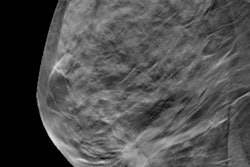
Adding digital breast tomosynthesis (DBT) to 2D screening mammography has a different effect based on who's reading the images, according to a new study published online March 13 in Radiology. It improves specificity for all readers, but sensitivity improvements are reserved for more junior radiologists.
DBT has been lauded for its ability to find more cancers and reduce recall rates. But it hasn't been clear how adding it to standard 2D mammography improves the diagnostic performance of readers, wrote a group led by Lorraine Tucker of the University of Cambridge in the U.K.
"There is a need to establish whether the addition of DBT is equally effective in improving the performance of readers with different mammographic experience," the authors wrote. "In this study we assessed whether the improved reader performance seen overall with the addition of DBT to 2D mammography varies with reader experience in reading 2D mammograms."
More sensitive
For the study, Tucker and colleagues used data collected from the U.K. National Health Service (NHS) Breast Screening Program's Tomosynthesis With Digital Mammography (TOMMY) trial, which started in 2010 and compared tomosynthesis with digital mammography. The current analysis included 7,060 cases that were used to assess reader performance with 2D mammograms alone, DBT plus 2D mammograms, and synthetic 2D mammograms with DBT images.
 Dr. Fiona Gilbert from the University of Cambridge.
Dr. Fiona Gilbert from the University of Cambridge."We conducted [the TOMMY] retrospective reading study to determine whether or not DBT had greater sensitivity and specificity compared to 2D alone," corresponding author Dr. Fiona Gilbert told AuntMinnie.com via email. "As we had multiple readers in the study, [for this research] we were able to perform a subgroup analysis to see whether each reader had the same benefit from the technology."
The readers consisted of 19 radiologists, three radiographers, and two breast clinicians with a median of 10 years of experience. The median number of cases that readers interpreted per year was 8,000. The researchers analyzed specificity and sensitivity according to reader type and years and volume of experience.
Specificity improved when DBT was added to 2D mammography for all readers, and sensitivity improved in 79% of them, Tucker and colleagues found. However, the technology particularly improved sensitivity in readers with fewer than 10 years of experience (from 86% to 91%) and in those with total mammographic experience of fewer than 80,000 cases (from 88% to 92%).
| Tomo performance by reader experience | |||||
| 2D mammography | DBT + 2D mammography | ||||
| Sensitivity | Specificity | Sensitivity | Specificity | ||
| Years of experience | |||||
| < 10 | 86% | 55% | 91% | 69% | |
| ≥ 10 | 88% | 53% | 88% | 65% | |
| Mammograms per year | |||||
| < 8,000 | 86% | 56% | 88% | 67% | |
| ≥ 8,000 | 88% | 53% | 90% | 66% | |
| Total experience | |||||
| < 80,000 | 88% | 55% | 92% | 66% | |
| ≥ 80,000 | 86% | 53% | 87% | 67% | |
| Type of reader | |||||
| Radiologist | 86% | 56% | 88% | 68% | |
| Radiographer | 87% | 49% | 89% | 67% | |
| Breast clinician | 94% | 46% | 99% | 55% | |
"All readers benefited from the addition of DBT to 2D, but those who were less experienced or in a low-volume practice derived more benefit," Gilbert said.
Performance boost
The study findings suggest that DBT could be particularly useful for a practice's junior readers -- or those with high recall rates, Gilbert told AuntMinnie.com.
"Readers who have high recall rates will definitely benefit from using DBT, as this will result in a reduction of the number of cases they perceive as being worrisome," she said. "In addition, practices might consider their workforce and decide that their more junior colleagues should be reading DBT cases, while their more experienced readers take the 2D workload."



















